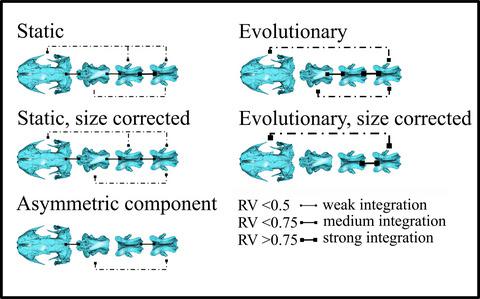当前位置:
X-MOL 学术
›
J. Zool. Syst. Evol. Res.
›
论文详情
Our official English website, www.x-mol.net, welcomes your feedback! (Note: you will need to create a separate account there.)
Morphological integration and serial homology: A case study of the cranium and anterior vertebrae in salamanders
Journal of Zoological Systematics and Evolutionary Research ( IF 1.9 ) Pub Date : 2020-03-10 , DOI: 10.1111/jzs.12374 Aleksandar Urošević 1 , Maja Ajduković 1 , Jan W. Arntzen 2 , Ana Ivanović 2, 3
Journal of Zoological Systematics and Evolutionary Research ( IF 1.9 ) Pub Date : 2020-03-10 , DOI: 10.1111/jzs.12374 Aleksandar Urošević 1 , Maja Ajduković 1 , Jan W. Arntzen 2 , Ana Ivanović 2, 3
Affiliation

|
Serial homology or the repetition of equivalent developmental units and their derivatives is a phenomenon encountered in a variety of organisms, with the vertebrate axial skeleton as one of the most notable examples. Serially homologous structures can be viewed as an appropriate model system for studying morphological integration and modularity, due to the strong impact of development on their covariation. Here, we explored the pattern of morphological integration of the cranium and the first three serially homologous structures (atlas, first, and second trunk vertebrae) in salamandrid salamanders, using micro‐CT scanning and three‐dimensional geometric morphometrics. We explored the integration between structures at static and evolutionary levels. Effects of allometry on patterns of modularity were also taken into account. At the static level (within species), we analyzed inter‐individual variation in shape to detect functional modules and intra‐individual variation to detect developmental modules. Significant integration (based on inter‐individual variation) among all structures was detected and allometry is shown to be an important integrating factor. The pattern of intra‐individual, asymmetric variation indicates statistically significant developmental integration between the cranium and the atlas and between the first two trunk vertebrae. At the evolutionary level (among species), the cranium, atlas, and trunk vertebrae separate as different modules. Our results show that morphological integration at the evolutionary level coincides with morphological and functional differentiation of the axial skeleton, allowing the more or less independent evolutionary changes of the cranial skeleton and the vertebral column, regardless of the relatively strong integration at the static level. The observed patterns of morphological integration differ across levels, indicating different impacts of developmental and phylogenetic constraints and functional demands.
中文翻译:

形态整合和系列同源性::中颅骨和前椎骨的案例研究
序列同源性或等同的发育单位及其衍生物的重复是在各种生物中遇到的现象,脊椎动物的轴向骨架是最著名的例子之一。由于发展对其协变的强烈影响,系列同源结构可视为研究形态整合和模块性的合适模型系统。在这里,我们使用微CT扫描和三维几何形态计量学,探索了sal和sal的前三个连续同源结构(图集,第一和第二主干椎骨)的形态整合模式。我们探索了静态和进化水平上结构之间的整合。还考虑了异速测量对模块化模式的影响。在静态水平上(物种内),我们分析了个体之间的形状变异以检测功能模块,并分析了个体内部的变异以检测发育模块。在所有结构之间检测到重要的整合(基于个体间的差异),并且异速生长法是重要的整合因素。个体内不对称变异的模式表明,颅骨和地图集之间以及前两个主干椎骨之间在统计学上具有显着的发育整合。在进化水平上(在物种之间),颅骨,地图集和主干椎骨作为不同的模块分开。我们的结果表明,在进化水平上的形态整合与轴向骨架的形态和功能分化相吻合,不管在静态水平上相对强大的整合如何,都可以使颅骨和椎骨柱或多或少地具有独立的进化变化。观察到的形态学整合模式在各个水平上都不同,表明发育和系统发育限制以及功能需求的不同影响。
更新日期:2020-03-10
中文翻译:

形态整合和系列同源性::中颅骨和前椎骨的案例研究
序列同源性或等同的发育单位及其衍生物的重复是在各种生物中遇到的现象,脊椎动物的轴向骨架是最著名的例子之一。由于发展对其协变的强烈影响,系列同源结构可视为研究形态整合和模块性的合适模型系统。在这里,我们使用微CT扫描和三维几何形态计量学,探索了sal和sal的前三个连续同源结构(图集,第一和第二主干椎骨)的形态整合模式。我们探索了静态和进化水平上结构之间的整合。还考虑了异速测量对模块化模式的影响。在静态水平上(物种内),我们分析了个体之间的形状变异以检测功能模块,并分析了个体内部的变异以检测发育模块。在所有结构之间检测到重要的整合(基于个体间的差异),并且异速生长法是重要的整合因素。个体内不对称变异的模式表明,颅骨和地图集之间以及前两个主干椎骨之间在统计学上具有显着的发育整合。在进化水平上(在物种之间),颅骨,地图集和主干椎骨作为不同的模块分开。我们的结果表明,在进化水平上的形态整合与轴向骨架的形态和功能分化相吻合,不管在静态水平上相对强大的整合如何,都可以使颅骨和椎骨柱或多或少地具有独立的进化变化。观察到的形态学整合模式在各个水平上都不同,表明发育和系统发育限制以及功能需求的不同影响。



























 京公网安备 11010802027423号
京公网安备 11010802027423号